Global Cell Isolation Market Forecast
- The approximately US$4.1 Bn market (2022) for cell isolation likely to take a leap by 2030, reaching US$10.1 Bn
- Market valuation slated for an impressive CAGR of 13.9% between 2023 and 2030
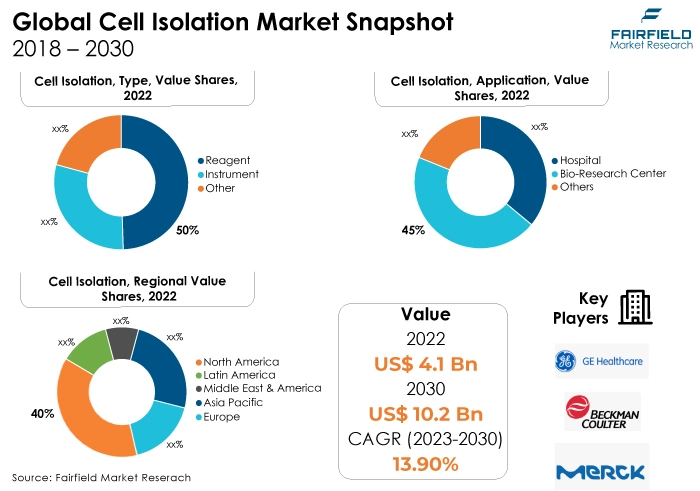
Quick Report Digest
- The key trend anticipated to fuel the cell isolation market growth is increasing research activities: rising research initiatives in fields such as cancer biology, stem cell research, and immunology are driving the demand for advanced cell isolation techniques and tools.
- Another major market trend expected to fuel the cell isolation market is ongoing technological advancements in cell isolation methods, including microfluidics and magnetic cell sorting, which are enhancing the efficiency and accuracy of the process.
- The prevalence of chronic diseases like cancer and autoimmune disorders is fueling the need for cell isolation techniques for diagnostic and therapeutic purposes.
- In 2022, reagents in the cell isolation market are considered a dominant category because they are essential components in various cell isolation methods, including immunomagnetic separation, fluorescence-activated cell sorting (FACS), and density gradient centrifugation.
- In terms of market share for cell isolation globally, research centres extensively utilise cell isolation techniques for experiments, leading to a substantial demand for reliable and efficient isolation methods.
- In 2022, hospitals are increasingly utilising cell isolation techniques, especially in areas like oncology, for diagnostic purposes due to the critical need for precise cell analysis. In oncology, understanding the specific characteristics of cancer cells is vital for accurate diagnosis, prognosis, and treatment planning.
- The North America region is a hub for technological innovations in biotechnology, resulting in a high adoption rate of advanced cell isolation techniques. The US is experiencing a surge in research activities, driving the demand for advanced cell isolation technologies.
- Asia Pacific, especially China, and Korea, is witnessing rapid market expansion due to the increasing investment in healthcare infrastructure, research facilities, and biotechnology companies.
A Look Back and a Look Forward - Comparative Analysis
The market for cell isolation is now expanding rapidly due to the rising need for cutting-edge therapeutic and diagnostic solutions across a range of medical specialties. The market is growing due to developments in cell isolation technologies and an increase in research being done in fields including immunology, cancer, and regenerative medicine. The necessity for accurate cell analysis has also increased due to the rising frequency of chronic illnesses and the requirement for personalised medication, which is driving the market.
The market witnessed staggered growth during the historical period 2018 - 2022. the cell isolation market experienced substantial growth, marked by significant technological advancements and a burgeoning focus on individualised patient treatments.
Innovations in reagents, instruments, and other cell isolation techniques have enhanced the efficiency and accuracy of the process. Moreover, research institutions, biotechnology companies, and hospitals increased their investments in cell isolation methodologies, contributing to the market's historical growth.
The cell isolation market is poised for continuous expansion. Anticipated technological breakthroughs, especially in microfluidics and automation, will revolutionise the isolation processes, making them more efficient and cost-effective.
Moreover, the increasing focus on regenerative medicine, stem cell therapy, and personalised healthcare solutions will drive the demand for advanced cell isolation techniques. Collaborations between research institutions, healthcare facilities, and industry players are expected to foster innovation and the development of cutting-edge cell isolation tools.
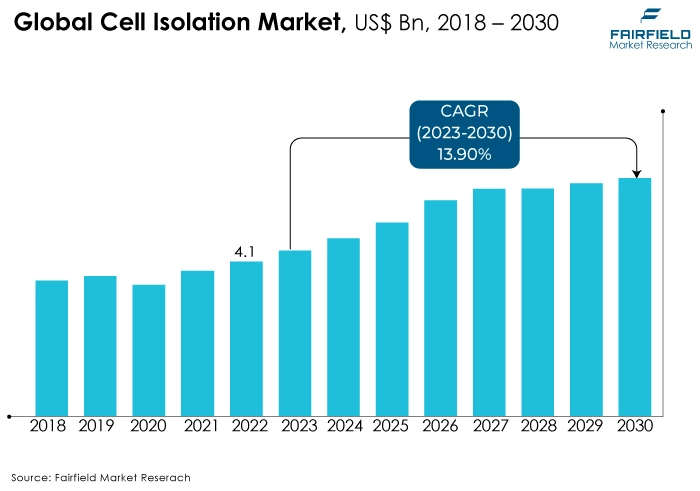
Key Growth Determinants
- Technical and Technological Advancements
The rapid advancements in cell isolation technologies and techniques are major drivers propelling the growth of the market. Innovative methods, such as microfluidics and magnetic-activated cell sorting (MACS), have significantly improved the precision, efficiency, and speed of cell isolation processes.
Automation and robotics have further enhanced the reproducibility, and scalability of these techniques, making them more accessible to researchers and clinicians. As these technologies continue to evolve, researchers are empowered to isolate specific cell populations with higher purity and viability, driving the market forward.
- Increasing Research in Biomedical Sciences
The expanding scope of research in biomedical sciences, including areas such as cancer biology, immunology, and regenerative medicine, has fueled the demand for advanced cell isolation methods. Researchers are increasingly relying on isolated cells to conduct in-depth studies, develop targeted therapies, and understand disease mechanisms at the cellular level.
Moreover, the rise in stem cell research and gene therapy applications has bolstered the need for precise cell isolation techniques. This growing interest in understanding cellular processes and developing therapies contributes significantly to the market expansion.
- Mounting Prevalence of Chronic Diseases
The demand for cell-based therapies and customised medicine has increased as chronic diseases including cancer, cardiovascular problems, and autoimmune ailments become more common. These therapeutic methods depend heavily on cell isolation, which makes it possible to isolate specific cell types for therapeutic uses. Targeted medicines and treatments are becoming more and more necessary as the worldwide burden of chronic diseases rises.
The isolation of therapeutic cells, including immune and stem cells, which are used in a variety of regenerative medicine applications, is made easier by cell isolation techniques. Consequently, the market is driven by the growing need to develop tailored treatments for individuals suffering from chronic diseases.
Major Growth Barriers
- Cost and Budgetary Constraints
The cell isolation market is the high cost associated with advanced cell isolation technologies and reagents. The initial investment required for sophisticated equipment and specialised reagents can strain the budgets of research institutions and healthcare facilities, particularly those in developing regions.
The financial constraint often hampers the adoption of cutting-edge cell isolation methods, limiting access to advanced technologies and impeding market growth.
- Technical Challenges, and Standardisation Concerns
The cell isolation process is intricate and requires a high level of technical expertise. Variability in sample quality, operator skills, and equipment calibration can lead to inconsistent results, affecting the reproducibility of experiments. Standardising cell isolation protocols across different laboratories and ensuring uniformity in results pose significant challenges.
Additionally, evolving cell isolation techniques often need more standardised guidelines, creating difficulties in comparing outcomes between different studies. These technical challenges and the lack of universal protocols restrain the seamless adoption of cell isolation methods in various research and clinical applications.
Key Trends and Opportunities to Look at
- Rapid Advancements in Microfluidic Technologies
Microfluidic-based cell isolation methods are gaining momentum due to their efficiency and low sample requirements. These technologies enable precise isolation of specific cell populations, enhancing research applications. Companies are investing in miniaturised systems, driving the trend's popularity globally.
- Growing Emphasis on Automated Cell Isolation Systems
The market is witnessing a shift towards automation, driven by the need for high throughput and reproducibility. Automated cell isolation systems are becoming popular in research and clinical labs, ensuring consistent results. Key players are focusing on developing user-friendly, automated platforms to meet the rising demand.
- Increasing Focus on Rare Cell Isolation
As research delves deeper into rare cell populations, technologies for isolating these cells are evolving. High-precision techniques, like immunomagnetic separation and flow cytometry, are gaining prominence. Companies are developing specialised reagents and instruments, capitalising on the demand for isolating rare cells in diagnostics and research.
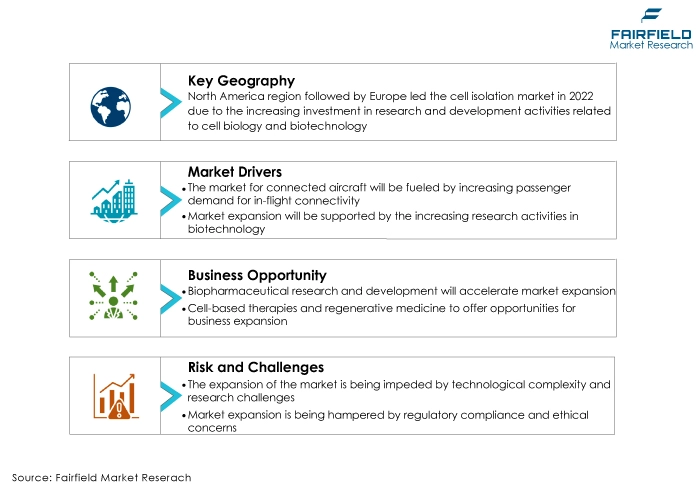
How Does the Regulatory Scenario Shape this Industry?
The Cell Isolation Market is significantly influenced by regulatory frameworks that ensure the safety, efficacy, and quality of products. Strict regulations are enforced by regulatory agencies like the European Medicines Agency (EMA) in the EU, and the US FDA. Cell-based medicines and products are supervised by the FDA's Centre for Biologics Evaluation and Research (CBER), which makes sure they adhere to current good manufacturing practise (cGMP) guidelines.
Cell-based product guidelines are set by the European Directorate for the Quality of Medicines and Healthcare (EDQM) inside the European Union. Moreover, region-specific changes, like the EU’s implementation of the General Data Protection Regulation (GDPR) for data privacy, impact cell isolation equipment with data management features.
Additionally, international standards like ISO 13485 for medical devices play a pivotal role. Companies must adhere to these regulations, ensuring product safety and efficacy, thereby shaping the industry's landscape, and promoting innovation and compliance within the cell isolation market.
Fairfield’s Ranking Board
Top Segments
- Reagents Represent Nearly 50% Market Share
The dominant category in the cell isolation market is reagents in 2022. Reagents play a fundamental role in various cell isolation techniques, offering high specificity and efficiency, making them essential for researchers and clinicians.
Reagents are widely utilised due to their versatility in isolating different cell types, making them a preferred choice among professionals. In terms of market share percentage, reagents hold approximately 50% of the total market share, indicating their dominance and widespread usage.
Instruments, on the other side, is expected to display the fastest rate of growth. Advances in technology have led to the development of sophisticated cell isolation instruments, offering higher automation, precision, and throughput. These instruments cater to the increasing demand for high-throughput cell isolation in research and clinical applications. The Instruments category is experiencing rapid growth, with an annual growth rate of approximately 8%.
- Bio-Research Centres Surge Ahead, Hospitals Follow Suit
In 2022, the dominant application category is bio-research centres. Bio-Research Centres extensively use cell isolation techniques for diverse research purposes, including drug discovery, cancer research, and stem cell studies. These centres require a wide range of cell isolation methods, contributing significantly to the demand for cell isolation products.
Bio-research centres account for approximately 45% of the total market share, indicating their dominance and consistent demand in the market. The fastest-growing market category, however, is hospitals. Hospitals have seen a notable increase in adopting cell isolation techniques, especially in areas like oncology and personalised medicine.
Precise cell analysis is essential in diagnostics and treatment planning, driving the demand for cell isolation products in hospital settings. The hospital category is experiencing a rapid growth rate of approximately 10% annually, reflecting the expanding applications of cell isolation techniques in clinical settings.
Regional Frontrunners
North America Presents a Highly Fertile Ground for Market Expansion
North America remains the largest revenue-contributing region in the global cell isolation market, accounting for approximately 40% of the market share. This dominance is attributed to several factors. This growth can be attributed to various factors.
The region has a well-established healthcare infrastructure, advanced research facilities, and a significant presence of prominent biotechnology and pharmaceutical companies. These factors support extensive research and development efforts, leading to a continuous demand for state-of-the-art cell isolation technologies.
Moreover, strategic collaborations between academic research institutions and industry players, coupled with supportive government initiatives and funding for life sciences research, enhance the adoption of cell isolation technologies. These factors collectively contribute to North America's substantial market share and signify its potential for significant growth in the cell isolation market during the forecast period.
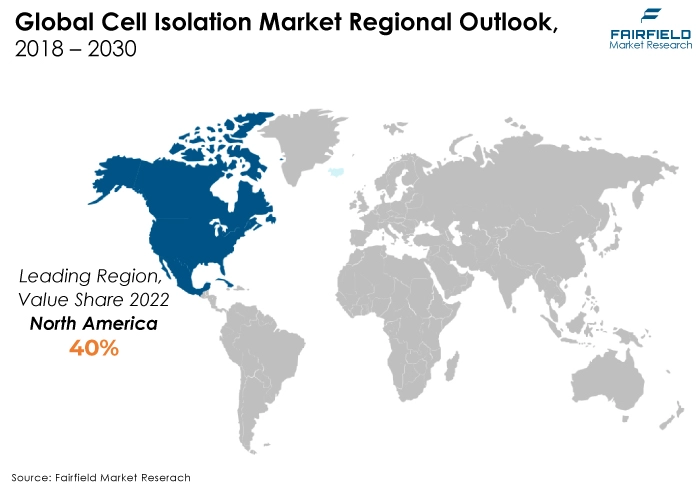
China, Japan, and India Stand out to Uplift the Prospects of Asia Pacific
Asia Pacific is expected to experience substantial sales growth in the cell isolation market in the forecast period, with an estimated market. The region's significant population base and increasing healthcare investments drive the demand for advanced cell isolation techniques, particularly in countries like China, Japan, and India, where medical research and healthcare services are rapidly expanding.
Furthermore, supportive government initiatives and funding for life sciences research projects, along with collaborations between research institutions and biotechnology companies, contribute significantly to the market growth in Asia Pacific. These factors create a robust market environment, making Asia Pacific the primary revenue contributor in the global cell isolation market.
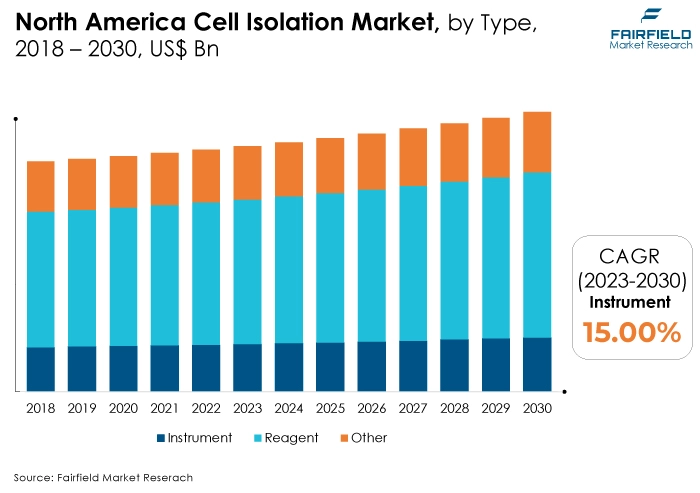
Fairfield’s Competitive Landscape Analysis
In the competitive landscape, innovation is the key driver. Companies are investing heavily in research to develop cutting-edge technologies that offer higher yields, increased purity, and faster isolation times. Strategic collaborations with research institutions and universities are fostering an environment of knowledge exchange, pushing the boundaries of what cell isolation techniques can achieve.
Who are the Leaders in Global Cell Isolation Space?
- Beckman Coulter
- Becton Dickinson and Company
- GE Healthcare
- Merck KGaA
- Miltenyi Biotec
- STEMCELL Technologies Inc.
- Terumo BCT
- Thermo Fisher Scientific
- PluriSelect Life Science UG & Co. KG
- Danaher
- Corning, Inc.
- GenScript
- BD Bioscience
Significant Company Developments
New Product Launch
- August 2020: Beckman Coulter, a clinical diagnostics company, has recently introduced the ARS-CoV-2 Immunoglobulin M (IgM) assay. This novel antibody test has exhibited a specificity of 99.9% when tested against 1,400 negative samples, and a sensitivity of 98.3% within 15-30 days after the onset of symptoms.
- October 2022: Thermo Fisher Scientific has introduced a new solution for cell therapy manufacturing, which involves a closed and automated process for isolating cells and removing beads. This advanced technology enhances the efficiency of cell purity and isolation, as well as boosts the recovery of target cells, ultimately enabling scalable cell therapy manufacturing.
- October 2020:GE Healthcare has gained the ability to market Serena Bright in the United States thanks to a supply arrangement. Serena Bright, the very first contrast-enhanced guided biopsy product available, will provide valuable assistance to both patients and clinicians in their battle against breast cancer.
Distribution Agreement
- April 2019: Becton, Dickinson and Company (BD) introduced BD BACTEC platelet quality control media, enabling microbiology labs, blood banks, and transfusion services to spot tainted platelet units.
- June 2022: Terumo BCT and GenCure collaborated to advance cell and gene therapy manufacturing solutions.
An Expert’s Eye
Demand and Future Growth
The escalating demand for advanced therapies and personalised medicine. With an ageing population and increasing incidences of chronic diseases, there's a growing need for precise and efficient cell isolation techniques. Researchers and clinicians are exploring novel therapies, including stem cell treatments and immunotherapies, which rely heavily on robust cell isolation methods.
Moreover, the expanding fields of regenerative medicine and cancer research are pushing the boundaries of what can be achieved with cell-based therapies.
Supply Side of the Market
According to our analysis, the challenge lies in meeting the escalating demand with a consistent supply of high-quality, pure cells. Ensuring a stable supply chain for reagents, instruments, and other cell isolation components is crucial. The industry players must invest in research and development to create automated, scalable, and cost-effective solutions.
Moreover, navigating the regulatory landscape, especially concerning the use of stem cells, necessitates a deep understanding of evolving guidelines and ethical considerations. Companies must invest in robust quality control measures to maintain the integrity of isolated cells, meeting the stringent standards set by regulatory authorities.
In addition, staying up-to-date with advancements in technology and continuously improving isolation techniques is essential for companies to stay competitive in the market. This requires collaboration with experts in the field and fostering partnerships with research institutions to ensure access to cutting-edge knowledge and resources.
The Global Cell Isolation Market is Segmented as Below:
By Type:
- Reagent
- Instrument
- Other
By Automation:
- Bio-Research Centres
- Hospital
- Others
By Geographic Coverage:
- North America
- U.S.
- Canada
- Europe
- Germany
- U.K.
- France
- Italy
- Turkey
- Russia
- Rest of Europe
- Asia Pacific
- China
- Japan
- South Korea
- India
- Southeast Asia
- Rest of Asia Pacific
- Latin America
- Brazil
- Mexico
- Argentina
- Rest of Latin America
- Middle East & Africa
- GCC
- South Africa
- Egypt
- Nigeria
- Rest of the Middle East & Africa
1. Executive Summary
1.1. Global Cell Isolation Market Snapshot
1.2. Future Projections
1.3. Key Market Trends
1.4. Regional Snapshot, by Value, 2022
1.5. Analyst Recommendations
2. Market Overview
2.1. Market Definitions and Segmentations
2.2. Market Dynamics
2.2.1. Drivers
2.2.2. Restraints
2.2.3. Market Opportunities
2.3. Value Chain Analysis
2.4. Porter’s Five Forces Analysis
2.5. COVID-19 Impact Analysis
2.5.1. Supply
2.5.2. Demand
2.6. Impact of Ukraine-Russia Conflict
2.7. Economic Overview
2.7.1. World Economic Projections
2.8. PESTLE Analysis
3. Global Cell Isolation Market Outlook, 2018 - 2030
3.1. Global Cell Isolation Market Outlook, by Type, Value (US$ Bn), 2018 - 2030
3.1.1. Key Highlights
3.1.1.1. Reagent
3.1.1.2. Instrument
3.1.1.3. Other
3.2. Global Cell Isolation Market Outlook, by Application, Value (US$ Bn), 2018 - 2030
3.2.1. Key Highlights
3.2.1.1. Bio-Research Center
3.2.1.2. Hospital
3.2.1.3. Others
3.3. Global Cell Isolation Market Outlook, by Region, Value (US$ Bn), 2018 - 2030
3.3.1. Key Highlights
3.3.1.1. North America
3.3.1.2. Europe
3.3.1.3. Asia Pacific
3.3.1.4. Latin America
3.3.1.5. Middle East & Africa
4. North America Cell Isolation Market Outlook, 2018 - 2030
4.1. North America Cell Isolation Market Outlook, by Type, Value (US$ Bn), 2018 - 2030
4.1.1. Key Highlights
4.1.1.1. Reagent
4.1.1.2. Instrument
4.1.1.3. Other
4.2. North America Cell Isolation Market Outlook, by Application, Value (US$ Bn), 2018 - 2030
4.2.1. Key Highlights
4.2.1.1. Bio-Research Center
4.2.1.2. Hospital
4.2.1.3. Others
4.2.2. BPS Analysis/Market Attractiveness Analysis
4.3. North America Cell Isolation Market Outlook, by Country, Value (US$ Bn), 2018 - 2030
4.3.1. Key Highlights
4.3.1.1. U.S. Cell Isolation Market by Type, Value (US$ Bn), 2018 - 2030
4.3.1.2. U.S. Cell Isolation Market, by Application, Value (US$ Bn), 2018 - 2030
4.3.1.3. Canada Cell Isolation Market by Type, Value (US$ Bn), 2018 - 2030
4.3.1.4. Canada Cell Isolation Market, by Application, Value (US$ Bn), 2018 - 2030
4.3.2. BPS Analysis/Market Attractiveness Analysis
5. Europe Cell Isolation Market Outlook, 2018 - 2030
5.1. Europe Cell Isolation Market Outlook, by Type, Value (US$ Bn), 2018 - 2030
5.1.1. Key Highlights
5.1.1.1. Reagent
5.1.1.2. Instrument
5.1.1.3. Other
5.2. Europe Cell Isolation Market Outlook, by Application, Value (US$ Bn), 2018 - 2030
5.2.1. Key Highlights
5.2.1.1. Bio-Research Center
5.2.1.2. Hospital
5.2.1.3. Others
5.2.2. BPS Analysis/Market Attractiveness Analysis
5.3. Europe Cell Isolation Market Outlook, by Country, Value (US$ Bn), 2018 - 2030
5.3.1. Key Highlights
5.3.1.1. Germany Cell Isolation Market by Type, Value (US$ Bn), 2018 - 2030
5.3.1.2. Germany Cell Isolation Market, by Application, Value (US$ Bn), 2018 - 2030
5.3.1.3. U.K. Cell Isolation Market by Type, Value (US$ Bn), 2018 - 2030
5.3.1.4. U.K. Cell Isolation Market, by Application, Value (US$ Bn), 2018 - 2030
5.3.1.5. France Cell Isolation Market by Type, Value (US$ Bn), 2018 - 2030
5.3.1.6. France Cell Isolation Market, by Application, Value (US$ Bn), 2018 - 2030
5.3.1.7. Italy Cell Isolation Market by Type, Value (US$ Bn), 2018 - 2030
5.3.1.8. Italy Cell Isolation Market, by Application, Value (US$ Bn), 2018 - 2030
5.3.1.9. Turkey Cell Isolation Market by Type, Value (US$ Bn), 2018 - 2030
5.3.1.10. Turkey Cell Isolation Market, by Application, Value (US$ Bn), 2018 - 2030
5.3.1.11. Russia Cell Isolation Market by Type, Value (US$ Bn), 2018 - 2030
5.3.1.12. Russia Cell Isolation Market, by Application, Value (US$ Bn), 2018 - 2030
5.3.1.13. Rest of Europe Cell Isolation Market by Type, Value (US$ Bn), 2018 - 2030
5.3.1.14. Rest of Europe Cell Isolation Market, by Application, Value (US$ Bn), 2018 - 2030
5.3.2. BPS Analysis/Market Attractiveness Analysis
6. Asia Pacific Cell Isolation Market Outlook, 2018 - 2030
6.1. Asia Pacific Cell Isolation Market Outlook, by Type, Value (US$ Bn), 2018 - 2030
6.1.1. Key Highlights
6.1.1.1. Reagent
6.1.1.2. Instrument
6.1.1.3. Other
6.2. Asia Pacific Cell Isolation Market Outlook, by Application, Value (US$ Bn), 2018 - 2030
6.2.1. Key Highlights
6.2.1.1. Bio-Research Center
6.2.1.2. Hospital
6.2.1.3. Others
6.2.2. BPS Analysis/Market Attractiveness Analysis
6.3. Asia Pacific Cell Isolation Market Outlook, by Country, Value (US$ Bn), 2018 - 2030
6.3.1. Key Highlights
6.3.1.1. China Cell Isolation Market by Type, Value (US$ Bn), 2018 - 2030
6.3.1.2. China Cell Isolation Market, by Application, Value (US$ Bn), 2018 - 2030
6.3.1.3. Japan Cell Isolation Market by Type, Value (US$ Bn), 2018 - 2030
6.3.1.4. Japan Cell Isolation Market, by Application, Value (US$ Bn), 2018 - 2030
6.3.1.5. South Korea Cell Isolation Market by Type, Value (US$ Bn), 2018 - 2030
6.3.1.6. South Korea Cell Isolation Market, by Application, Value (US$ Bn), 2018 - 2030
6.3.1.7. India Cell Isolation Market by Type, Value (US$ Bn), 2018 - 2030
6.3.1.8. India Cell Isolation Market, by Application, Value (US$ Bn), 2018 - 2030
6.3.1.9. Southeast Asia Cell Isolation Market by Type, Value (US$ Bn), 2018 - 2030
6.3.1.10. Southeast Asia Cell Isolation Market, by Application, Value (US$ Bn), 2018 - 2030
6.3.1.11. Rest of Asia Pacific Cell Isolation Market by Type, Value (US$ Bn), 2018 - 2030
6.3.1.12. Rest of Asia Pacific Cell Isolation Market, by Application, Value (US$ Bn), 2018 - 2030
6.3.2. BPS Analysis/Market Attractiveness Analysis
7. Latin America Cell Isolation Market Outlook, 2018 - 2030
7.1. Latin America Cell Isolation Market Outlook, by Type, Value (US$ Bn), 2018 - 2030
7.1.1. Key Highlights
7.1.1.1. Reagent
7.1.1.2. Instrument
7.1.1.3. Other
7.2. Latin America Cell Isolation Market Outlook, by Application, Value (US$ Bn), 2018 - 2030
7.2.1. Key Highlights
7.2.1.1. Bio-Research Center
7.2.1.2. Hospital
7.2.1.3. Others
7.2.2. BPS Analysis/Market Attractiveness Analysis
7.3. Latin America Cell Isolation Market Outlook, by Country, Value (US$ Bn), 2018 - 2030
7.3.1. Key Highlights
7.3.1.1. Brazil Cell Isolation Market by Type, Value (US$ Bn), 2018 - 2030
7.3.1.2. Brazil Cell Isolation Market, by Application, Value (US$ Bn), 2018 - 2030
7.3.1.3. Mexico Cell Isolation Market by Type, Value (US$ Bn), 2018 - 2030
7.3.1.4. Mexico Cell Isolation Market, by Application, Value (US$ Bn), 2018 - 2030
7.3.1.5. Argentina Cell Isolation Market by Type, Value (US$ Bn), 2018 - 2030
7.3.1.6. Argentina Cell Isolation Market, by Application, Value (US$ Bn), 2018 - 2030
7.3.1.7. Rest of Latin America Cell Isolation Market by Type, Value (US$ Bn), 2018 - 2030
7.3.1.8. Rest of Latin America Cell Isolation Market, by Application, Value (US$ Bn), 2018 - 2030
7.3.2. BPS Analysis/Market Attractiveness Analysis
8. Middle East & Africa Cell Isolation Market Outlook, 2018 - 2030
8.1. Middle East & Africa Cell Isolation Market Outlook, by Type, Value (US$ Bn), 2018 - 2030
8.1.1. Key Highlights
8.1.1.1. Reagent
8.1.1.2. Instrument
8.1.1.3. Other
8.2. Middle East & Africa Cell Isolation Market Outlook, by Application, Value (US$ Bn), 2018 - 2030
8.2.1. Key Highlights
8.2.1.1. Bio-Research Center
8.2.1.2. Hospital
8.2.1.3. Others
8.2.2. BPS Analysis/Market Attractiveness Analysis
8.3. Middle East & Africa Cell Isolation Market Outlook, by Country, Value (US$ Bn), 2018 - 2030
8.3.1. Key Highlights
8.3.1.1. GCC Cell Isolation Market by Type, Value (US$ Bn), 2018 - 2030
8.3.1.2. GCC Cell Isolation Market, by Application, Value (US$ Bn), 2018 - 2030
8.3.1.3. South Africa Cell Isolation Market by Type, Value (US$ Bn), 2018 - 2030
8.3.1.4. South Africa Cell Isolation Market, by Application, Value (US$ Bn), 2018 - 2030
8.3.1.5. Egypt Cell Isolation Market by Type, Value (US$ Bn), 2018 - 2030
8.3.1.6. Egypt Cell Isolation Market, by Application, Value (US$ Bn), 2018 - 2030
8.3.1.7. Nigeria Cell Isolation Market by Type, Value (US$ Bn), 2018 - 2030
8.3.1.8. Nigeria Cell Isolation Market, by Application, Value (US$ Bn), 2018 - 2030
8.3.1.9. Rest of Middle East & Africa Cell Isolation Market by Type, Value (US$ Bn), 2018 - 2030
8.3.1.10. Rest of Middle East & Africa Cell Isolation Market, by Application, Value (US$ Bn), 2018 - 2030
8.3.2. BPS Analysis/Market Attractiveness Analysis
9. Competitive Landscape
9.1. Manufacturer vs ApplicationHeatmap
9.2. Company Market Share Analysis, 2022
9.3. Competitive Dashboard
9.4. Company Profiles
9.4.1. Beckman Coulter (U.S.)
9.4.1.1. Company Overview
9.4.1.2. Product Portfolio
9.4.1.3. Financial Overview
9.4.1.4. Business Strategies and Development
9.4.2. Becton
9.4.2.1. Company Overview
9.4.2.2. Product Portfolio
9.4.2.3. Financial Overview
9.4.2.4. Business Strategies and Development
9.4.3. Dickinson, and Company (U.S.)
9.4.3.1. Company Overview
9.4.3.2. Product Portfolio
9.4.3.3. Financial Overview
9.4.3.4. Business Strategies and Development
9.4.4. GE Healthcare (U.K.)
9.4.4.1. Company Overview
9.4.4.2. Product Portfolio
9.4.4.3. Financial Overview
9.4.4.4. Business Strategies and Development
9.4.5. Merck KGaA (U.S.)
9.4.5.1. Company Overview
9.4.5.2. Product Portfolio
9.4.5.3. Financial Overview
9.4.5.4. Business Strategies and Development
9.4.6. Miltenyi Biotec (Germany)
9.4.6.1. Company Overview
9.4.6.2. Product Portfolio
9.4.6.3. Financial Overview
9.4.6.4. Business Strategies and Development
9.4.7. PluriSelect (Germany)
9.4.7.1. Company Overview
9.4.7.2. Product Portfolio
9.4.7.3. Financial Overview
9.4.7.4. Business Strategies and Development
9.4.8. STEMCELL Technologies Inc. (Canada)
9.4.8.1. Company Overview
9.4.8.2. Product Portfolio
9.4.8.3. Business Strategies and Development
9.4.9. Thermo Fisher Scientific
9.4.9.1. Company Overview
9.4.9.2. Product Portfolio
9.4.9.3. Financial Overview
9.4.9.4. Business Strategies and Development
9.4.10. Terumo BCT (U.S.)
9.4.10.1. Company Overview
9.4.10.2. Product Portfolio
9.4.10.3. Financial Overview
9.4.10.4. Business Strategies and Development
9.4.11. PluriSelect Life Science UG & Co. KG
9.4.11.1. Company Overview
9.4.11.2. Product Portfolio
9.4.11.3. Financial Overview
9.4.11.4. Business Strategies and Development
9.4.12. Danaher
9.4.12.1. Company Overview
9.4.12.2. Product Portfolio
9.4.12.3. Financial Overview
9.4.12.4. Business Strategies and Development
9.4.13. Corning Inc.
9.4.13.1. Company Overview
9.4.13.2. Product Portfolio
9.4.13.3. Financial Overview
9.4.13.4. Business Strategies and Development
9.4.14. GenScript
9.4.14.1. Company Overview
9.4.14.2. Product Portfolio
9.4.14.3. Financial Overview
9.4.14.4. Business Strategies and Development
9.4.15. BD Bioscience
9.4.15.1. Company Overview
9.4.15.2. Product Portfolio
9.4.15.3. Financial Overview
9.4.15.4. Business Strategies and Development
10. Appendix
10.1. Research Methodology
10.2. Report Assumptions
10.3. Acronyms and Abbreviations
|
BASE YEAR |
HISTORICAL DATA |
FORECAST PERIOD |
UNITS |
|||
|
2022 |
|
2018 - 2022 |
2023 - 2030 |
Value: US$ Million |
||
|
REPORT FEATURES |
DETAILS |
|
Type Coverage |
|
|
Automation Coverage |
|
|
Geographical Coverage |
|
|
Leading Companies |
|
|
Report Highlights |
Key Market Indicators, Macro-micro economic impact analysis, Technological Roadmap, Key Trends, Driver, Restraints, and Future Opportunities & Revenue Pockets, Porter’s 5 Forces Analysis, Historical Trend (2019-2021), Market Estimates and Forecast, Market Dynamics, Industry Trends, Competition Landscape, Category, Region, Country-wise Trends & Analysis, COVID-19 Impact Analysis (Demand and Supply Chain) |
